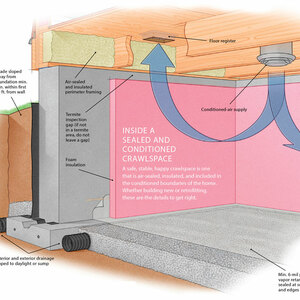I am currently dealing with a contractor who has done some work on our house and will be redoing all the soffits and fasica next week. I am also dealing with a roofing company who will be removing our old asphault shingle roof and will be installing a new metal roof. They are 2 different individuals.
The contractor is waiting for the roofers to remove the old roof and remove the drip edges around the house, and then he will install the new fascia and soffits. Then the roofers will come back and put in new drip edges and the new roof. Our roof is very steep and the roofers will be installing “walk boards” (I believe that is what they are called) up on the roof, so that they can walk up and down it. Part of the facia or trim installation is at the top of this dormer-type part of the house, and the contractor will need to use walk boards to get up on the roof next week to install the trim boards.
Can anyone tell me when the roofers walk boards are installed? Will they be attached on top of the underlayment? (what I used to call “tar paper?”) And then are they removed as the roofers go across the roof and install the metal? When they remove them, do they just slap some roofing tar or caulk on the holes which are remaining when the walk boards are removed? I am thinking that the contractor will arrive on Monday, when there is just underlayment on the roof, and he will install some walk boards for him to get up to this dormer to install the trim. And then will he just remove the walk boards and put something there to cover the holes. Is this how it should be done?
Oh, and how do the roofers remove the old shingles? Do they install walk boards then, and then remove the walk boards to do the underlayment? And then put them back when they need to install the metal? I am confused on how this works. This all sounds like a lot of holes in my new roof. Is this the way it is done? Thanks for any advice.
Sue


















Replies
I think your worrying about something that you don't need to.
Toekicks( as I call them) can be installed anytime they are needed, can be moved at will anytime they are needed.
I would think that the roofer will know when to use them! As would the carp that is going to do the work on the facia.
As far as when the toekicks are used it depends. If your house is old and has wood shakes under the asphalt shingles then there is probably skip sheeting(sort of a built in ladder) and toekicks aren't necessary until the decking material is installed.
Toekicks can and will be moved around as needed by the roofers and probably by your carp.
Doug
Hi Doug --Thanks. So, when these boards are moved around to facilitate the roofers installing various stuff, are the holes just left? Or do they fill them with something? It just seems a shame to me that they will cover this roof with underlayment, overlapping it correctly, and then there will be all these holes. Aren't they sort of defeating the purpose of properly installing the underlayment? Or is this just accepted? Thanks again for any advice.
Sue
Sue
Well the holes that they use for the brackets will be no different then the ones put in by the shingle nails.
The roofers will put the brackets down as they move up the roof. They will place them so that the next layer of shingles will cover the holes.
I've seen some roofers put a dab of tar on the hole when they take the bracket up to move or remove them. Not sure I'd count on that happening or if its all that necessary, I'll let a pro roofer tell you that.
If you have a good roofer you will be fine, they do this all the time and the toekicks are just a part of it.
Doug
Doug, you are assuming the will use brackets. Around here they just nail a 2x on top of the shingles. They may or may not seal the hole when they remove the boards. Heck I've seen quite a few where the left a couple boards installed when done. Tom
Douglasville, GA
Around here they just nail a 2x on top of the shingles
Well I should have prefaced it with, a professional will use brackets!
I guess I've seen the nailing of the 2X on top of the shingles but hoped that that wasn't the case here.
Doug
I hope that brackets are the method used here to. Might be something the homeowner would want to clarify beforehand.Tom
Douglasville, GA
you guys are talking about roof jacks with planks for shingle roofs. This one is a metal roof he has mentioned. The toebnoards are just for working off while doing demo and dry-in. on asteep roof the nail jholes left behind are of no concern.The guys who nail two bys right onto the shingles in Georgia are fulfilling the reputation that state seems to have for an abundance of hacks
Welcome to the Taunton University of Knowledge FHB Campus at Breaktime. where ... Excellence is its own reward!
Piffin
I was a little scared to read the post from you when I seen my notice via e-mail.
I knew toekick was wrong but couldn't come up with the right word. Must be thinking of my cabinets. Now that you say it, toe board is what we called them as well. I think I'm trying to mentally block it out. :)
I didn't catch the part about the metal roof! Maybe my reading skills need a little refinement as well as my roofing terminology!
I figured one of you pro-roofers would come along and tell it right.
Hey, I did know that you shouldn't nail a 2 X 4 over the shingles though!!! I guess that would make me a pro in GA.
Doug
it gives you a leg up anyway!
Welcome to the Taunton University of Knowledge FHB Campus at Breaktime. where ... Excellence is its own reward!
Toeboards is the name we've always used. There are a doxen different ways to proceed, especially with a steeper roof, so there is no way you can get the answer here. The roofers themselves might not even give you a clear answer, because job conditions might bring them to a change of practice on your roof.
I forsee a probelm here. The best way to re-roof is to remove the old and install the new as quickly as possible. by asking the roofers to delay their final work, you are asking them to incur the liability for leaks and damage thjat becomes very highly possible. I have never seen a carpenter who can trim a fascia from above on the roof without tearing and damaging the underlayment.
Franklu, I am totally suprised that the roofer is agreeing to this request. There is no reason a carp cannot trim things out from below on staging and get it all done before the roofing starts. If he prefers to work from above, he can still do it before the roof gets torn off by simply removing the edge himself.
There is something worng with this scenario and there will be finger pointing before it is finished.
Welcome to the
Taunton University of Knowledge FHB Campus at Breaktime.
where ...
Excellence is its own reward!
Relax. The holes from 'toeboards' or brackets are no cause for concern.
Consider the holes made while fastening the underlayment in the first place.
Consider also the many holes that will be produced by fastening the metal roofing.
The heck, you say?